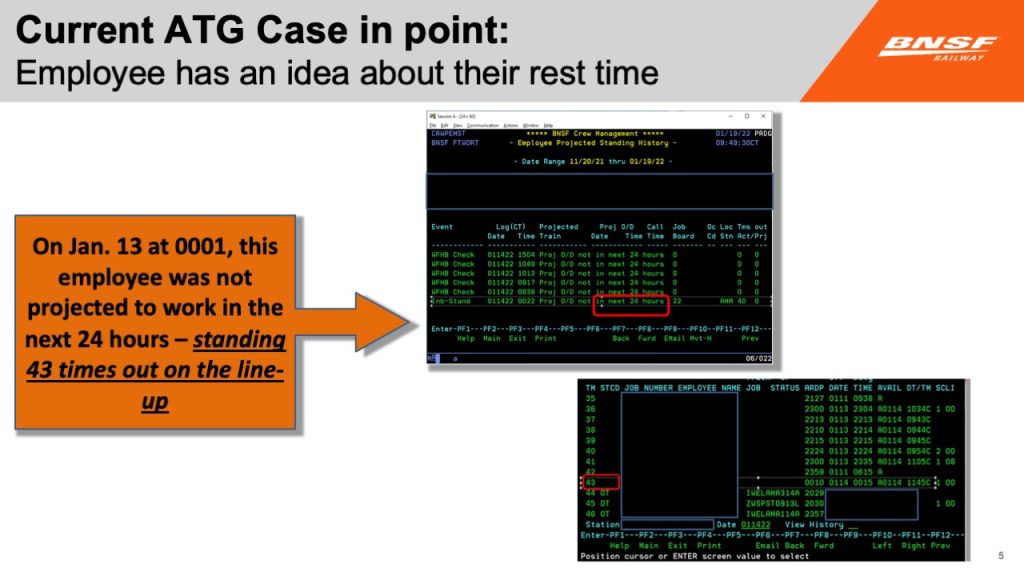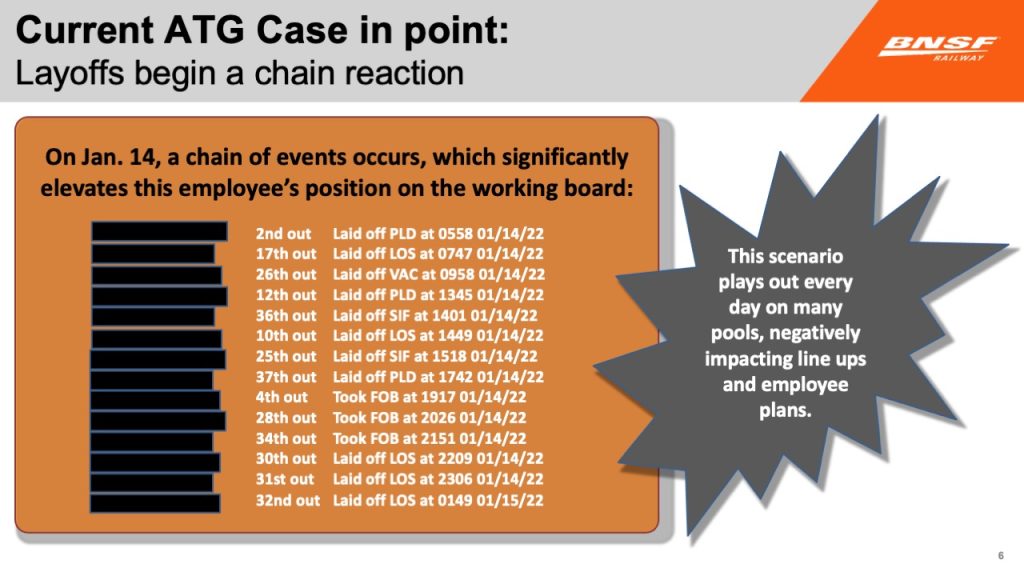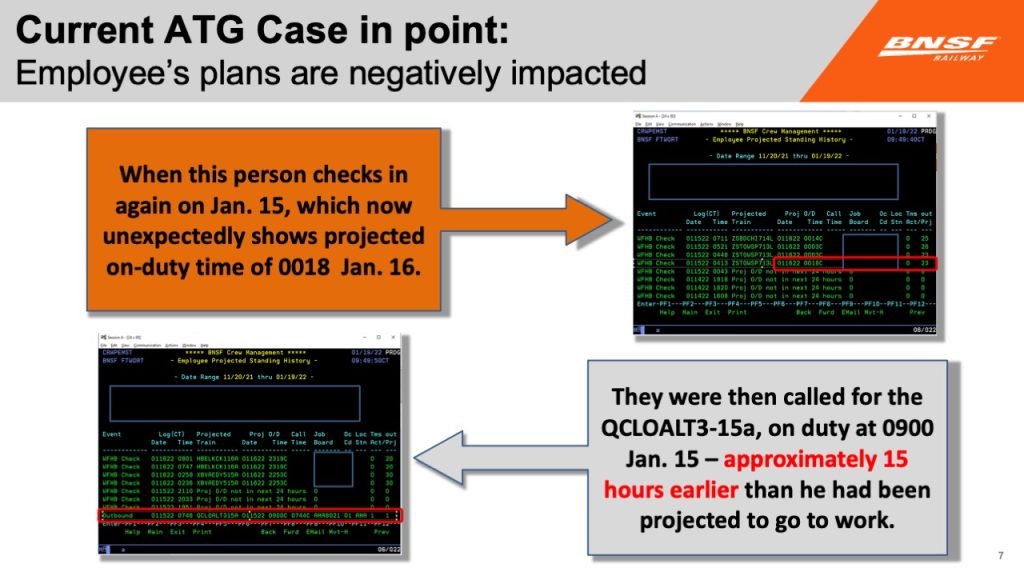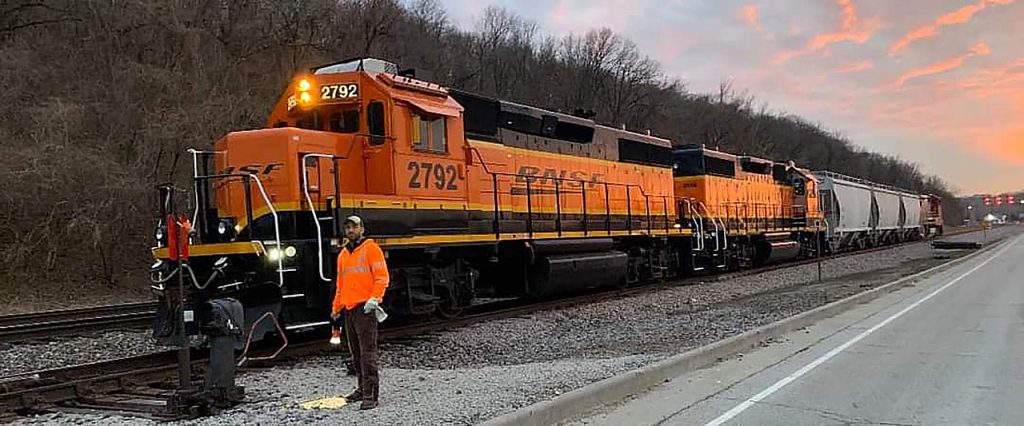
BNSF “Hi-Viz” Attendance Policy Rankling Rank-and-File (UPDATED JAN. 28)
Written by William C. Vantuono, Editor-in-Chief
After 20 years of no changes to its attendance guidelines, BNSF, citing “today’s competitive freight environment,” plans on Feb. 1 to institute a new system called “Hi-Viz” it says is “designed to provide employees with real-time information and greater flexibility, so they can make informed decisions about their work schedules.” The two largest unions representing some 17,000 BNSF TYE (train and engine service) and Yardmaster employees, the Transportation Division of the International Association of Sheet Metal, Air, Rail, and Transportation union (SMART-TD) and the Brotherhood of Locomotive Engineers and Trainmen (BLET), are—not unexpectedly—reacting negatively, calling the policy “the worst and most egregious attendance policy ever adopted by any rail carrier” and threatening a strike action, which the railroad filed suit to block.
“This policy update is consistent with practices across the transportation industry, while helping us safely and efficiently serve our customers and the communities that count on us,” BNSF said in a statement to Railway Age, describing Hi-Viz as a “time management dashboard that replaces our complicated legacy ATG (Attendance Guideline) system,” which is based on a three-month rolling period. Still undergoing “fine-tuning,” as BNSF expaned, Hi-Viz is a points-based system that “provides more certainty and better quality of life.”
Restraining Order Granted
On Jan. 25, U.S. district court judge Mark Pittman granted BNSF a Temporary Restraining Order blocking a SMART-TD/BLET strike. Following is the Order, in part, edited:
“The Court’s role is not to decide whether Plaintiff BNSF new High Visibility attendance standard is bad policy. Rather, the Court’s role is to determine whether the current labor dispute is either a ‘major’ or ‘minor’ dispute under the Railway Labor Act. (Under the RLA, minor disputes must be resolved by binding arbitration.)
“BNSF argues that the dispute is minor. Defendants SMART-TD and BLET (collectively, the ‘Unions’) argue that it is major. And based on their respective positions, the Parties are adamant about what happens next. BNSF insists that because the RLA has no status quo requirement for minor disputes, BNSF can, and will, implement the Hi-Viz attendance standard on Feb. 1, 2022. The Unions, however, insist that because the RLA grants them the right to engage in self-help during a major dispute, the Unions can, and will, exercise their right to strike on the day the policy is implemented.
“At this stage in the proceedings, the Court is not deciding whether this dispute is either major or minor as a matter of law. Instead, the Court is merely deciding whether ‘there is a substantial likelihood that the movant will prevail on the merits.’ Based on the Parties’ past practice, BNSF has established a substantial likelihood of success on the merits that implementing the Hi-Viz attendance standard is ‘arguably justified by the terms of the parties collective bargaining agreement’ such that the dispute is minor … The Court therefore concludes that BNSF has established a substantial likelihood that any resort to self-help by the Unions would violate the RLA.
“And without a temporary restraining order barring an ‘illegal strike over a minor dispute,’ BNSF would suffer substantial, immediate, and irreparable harm. The Unions, however, will not suffer any harm as a result of a temporary restraining order that this Court, or an arbitrator, cannot remedy. The balance of harms therefore weighs in favor of injunctive relief. The record further establishes that a strike would exacerbate our current supply-chain crisis—harming the public at large, not just BNSF. A temporary restraining order will thus serve, rather than disserve, the public interest. Accordingly, the Court concludes that granting a temporary restraining order is appropriate. In this Court’s experience, [prolonged] fights in federal court between unions and management only delay the inevitable negotiations between the parties. Frequently, such fights benefit no one, and the American consumer is left to bear the cost.
“Accordingly, the Court ORDERS that, for the duration of this Temporary Restraining Order, SMART-TD and BLET—as well as their divisions, lodges, locals, officers, agents, employees, members, and all persons acting in concert or participation with any of them—are TEMPORARILY RESTRAINED and ENJOINED from authorizing, encouraging, permitting, calling, or otherwise engaging in any strikes, work stoppages, picketing, slowdowns, sickouts, or other self-help against BNSF or its operating rail subsidiaries over any dispute relating to the Hi Viz attendance standards.
“The Court furthers ORDERS that SMART-TD and BLET, and their national and local officers, shall immediately undertake all reasonable efforts to prevent and discourage their respective divisions, lodges, locals, officers, agents, employees, members, and all person acting in concert with any of them, from engaging in conduct enjoined by this Order.”
SMART-TD and BLET issued directive to their members instructing them to comply with the temporary restraining order. SMRT-TD said: “Your Union will continue to challenge BNSF’s Hi Viz policy in court and will seek to have the Court’s Order lifted. However, so long as the Order remains in place, all SMART-TD members must comply. We are a nation of laws and will abide by those laws, and we expect each and every one of our members to do the same.”
DOWNLOAD THE SMART-TD NOTICE TO MEMBERS, WITH THE COURT ORDER ATTACHED:
UNIONS SEEK INJUNCTIONS
BLET and SMART-TD on Jan. 27 filed answers and counterclaims in the District Court seeking a Preliminary Injunction and Permanent Injunction against Hi-Viz implementation. “BLET and SMART-TD will continue to use every legal means available to prevent the implementation of the proposed policy,” the unions said in a joint statement. “As was advised when the Temporary Restraining Order was provided to all General Committees and Local Divisions/Locals, BLET and SMART-TD will continue to challenge BNSF’s Hi-Viz policy in court and will seek to have the Court’s Order lifted.”
Download BLET’s Answers and Counterclaims:
Hi-Viz Explained
Under the legacy ATG system, employees can only, for example, “have an idea about their rest time.” Layoffs (not furloughs) “begin a chain reaction” where an employee’s plans “are negatively impacted”:



With Hi-Viz, an employee starts with 30 “points.” “Point deductions,” which currently range anywhere from 2 to 25 but could change, are based on type of service and the day an “Event” (mark-off) begins. Unavailable time is measured in 24-hour increments. The highest point deductions are assessed for situations like NOS (No Shows) and EMC (Missed Calls).
There are HIDs (“High Impact Days”). For an Unassigned shift, an Event is defined as “occurring on the day of the HID”; an “Unavailable Event” is defined as “prior to the HID, and the employee is not marked up by 0600 on the HID.” For an Assigned shift, it’s when “an employee misses their assigned shift on the HID.”
A “Conjunction Penalty” (CP) applies only to Unavailable Events and Events “that immediately (not separated by a work event) precedes or follows a VAC (Layoff Vacation), PLD (Paid Leave Day), UNB (Union Business), SRS, FML (Family Medical Leave Act ) or CLD. Employees are charged an additional 2 points for Unassigned Service; an additional 3 points for Assigned Service, except for EMC, LOC (Layoff On Call) and NOS. Unavailable Events include LOS (Sick), LOP (Personal Business), SIF (Sickness in Family), FEM (Family Emergency), LOF (Fatigue), LXU (Failure to Take Notification), LFT (Failure to Tie Up), LOA (Layoff Active Board/Away Terminal or After Start of Shift) and LOD (Layoff Dressed and Ready to Work).
There are “Good Attendance Credits.” An employee is awarded a Good Attendance Credit “for any 14-day period they work without an Unavailable Event, NOS, EMC or LOC, and in which they are not otherwise absent from work for any reason, apart from Training/Rules, LET (Engineer Training), LIT (working Lite Duty), Company Business, Military Leave/NGD with supporting LES and/or orders and any type of Rest.” Good Attendance Credits are also given if the employee has “no absences/leave other than those listed in 2.b.ii (E.g. does not have DIF, FML/PFM, FUR, LAM, LOJ, MED, MEV, LOI, HFS, LAB, R79, PLD, SUA/SUT, UNB, VAC, etc.)” or “has no bump board time more than 2 hours after taking notification.”
In terms of discipline, “each time an employee exhausts their points (the balance reaches or falls below zero), they are subject to discipline. The point total is reset to 15. The Discipline Progression remains the same: 10-day, 20-day, Dismissal. If an employee remains Hi-Viz-discipline-free for 24 months, then their Hi-Viz progression is reset. Therefore, the next infraction would be a 10-day suspension.”
“We understand that change can be an adjustment, but working together with our employees, we believe we can adapt to meet today’s competitive freight environment,” BNSF told Railway Age.
Union Pushback
SMART-TD President Jeremy Ferguson and BLET National President Dennis Pierce said Hi-Viz “repudiates numerous collectively bargained agreements currently in place throughout the BNSF system. It is so restrictive that employees would be penalized for missing work to attend the funeral of an immediate family member. This unprecedented BNSF policy repudiates direct and clear contract language and, in application, will attempt to force our members to report for duty without regard for their medical condition as we struggle to come out of a pandemic. It also stands to take away any ability by our members to avoid working fatigued when they are routinely called without warning due to the complete lack of reliable train lineups, thus creating the potential for an even more unsafe railroad operation. So-called ‘forced overtime’ in an industry where safety is so critical not only repudiates our agreements, it stands to enact irreparable harm on hundreds of full-time employees whose non-workplace obligations prevent them from being at work every day of their life.”
“BNSF’s new Hi-Viz policy … penalizes employees—who in many cases have no assigned days off—any time they take time off work for practically any reason. In a FAQ that BNSF sent out to its employees, the carrier claimed that it ‘must improve crew availability to remain competitive in the industry’ and that the revised Hi-Viz program helps with this issue ‘by incentivizing consistent and reliable attendance.’ BNSF goes on to claim that a reduction in absenteeism will improve predictability of work assignments. However, the affected employees and their unions have made clear that they view BNSF’s approach to this issue as a juxtaposition. That is: If the carrier instead focused its efforts on predictable scheduling of assignments and competent management of its furloughed employees, there would be no need to impose such draconian attendance policies.
“Our members have simply had enough of the treatment they are enduring from BNSF. The Company’s half-baked attempt to characterize this policy as an ‘improvement’ and an ‘incentive’ is nothing short of disingenuous, and outright insulting. Although BNSF will not admit it, it has implemented so-called Precision Scheduled Railroading and is attempting to do more with less by intimidating our members, under threat of discipline and/or termination, into working additional shifts while they continue to furlough junior employees. Our members have worked tirelessly to keep goods moving during a global pandemic, but the railroad is once again placing monetary profits over people to appease shareholders and Wall Street. (Editor’s Comment: BNSF has one shareholder, Warren Buffett, does not hold earnings calls with Wall Street analysts like the other six Class I’s, and as such really doesn’t need to “appease shareholders and Wall Street” – William C. Vantuono.) Our membership is tired, frustrated and fed up with the treatment they continue to receive. As is the growing trend among all major rail carriers, the working conditions at BNSF have deteriorated to the point that there are many tenured employees leaving the railroad industry because they can no longer tolerate the treatment that they must endure on a daily basis. This new attendance policy may be the tipping point for what may be the ‘great railroad resignation.’”
Wilner Weighs In
Railway Age Capitol Hill Contributing Editor Frank N. Wilner, who was an officer of both the Association of American Railroads, the United Transportation Union and its successor SMART-TD, comments:
“Availability policies have long been a flash point in railroad labor-management relations, extending well previous to concerns of COVID-19, its spread and the medical necessity of quarantine that is limiting train crew availability.
“For sure, railroads run on 24/7 schedules, where weather and mechanical delays frequently play havoc with operational schedules and crew calling requirements. Unlike airlines, railroads do not have the luxury of repositioning equipment and crews during overnight hours. Moreover, railroads maintain “extra boards,” allowing workers time off with full benefits in exchange for them being on-call when needed.
“That doesn’t, however, excuse railroads from recognizing the personal lives of train crews. Even with Precision Scheduled Railroading, and despite that railroads built and implemented Positive Train Control, transforming the industry into a silicon marvel, train and engine service workers are not assured predictable schedules. The family lives of most train and engine service workers are chaotic, straining marriages and mental health.
“When working on the railroad, even the slightest lapse of situational awareness—whether from sleep deprivation or fear of supervisors—is more likely to result in loss of limb or life rather than minor cuts, sprains and bruises of other occupations. Medical science is in agreement that going to work tired is equivalent to going to work drunk.
“Attendant to availability policies, train and engine service workers often face unprovoked, unwarranted and unsettling harassment, threats and discipline from lower-level supervisors wholly untrained in the art of human resource management and otherwise lacking basic interpersonal skills.
“Although in railroad C-suites there are written policies, formal pronouncements, informal assurances and carefully worded press releases as to the value of employees and the priority level of safety, the words and deeds of those with boots on the ground speak more factually and forcefully than those reading morning reports in comfortable executive offices or at 30,000 feet from a private aircraft. Most relevant factually are the number and level of fines imposed on railroads for hostile actions against whistle blowers by the Occupational, Safety and Health Administration (OSHA).
“It would do well for those at the highest levels of railroad management to borrow from the playbook of railroad legends Alfred E. Perlman and E. Stanley Crane and spend days each month alongside those keeping the trains operating under some of the harshest employment conditions in America. There is a lot to be learned when one’s eyes are wide open in the real world than effectively wide shut while perusing operating plans, financial reports and legal arguments.
“While management is not a popularity contest, neither should it be an unpopularity contest—especially for an industry priding itself on being world-class.”
Employee Comments

Railway Age has been peppered with long, drawn-out, emotionally charged emails directed at BNSF’s upper management, imploring us to publish them. Following is a very brief sampling:
• “We have been blindsided by this new Hi-Viz policy, which provides zero inspiration, and has already begun to flip everything upside down for me, for my family, fellow coworkers (who have begun to quit, managers included) my health [and] my social life outside of this place … I respectfully ask that our top leadership at BNSF [and] whoever it was that was tasked to come up with this insane new policy that you withdraw it immediately. Come to the table with those of us who work in the trenches every day and together create a reasonable solution that would inspire every single one of us to remain safe, healthy and productive enough to competitively move our company forward.”
• “Your Hi-Viz Attendance Policy will place unattainable expectations on your employees to continue your ‘culture of safety’: a rested and healthy workforce will be inaccessible, and laborers will be penalized for their attempts to lay off sick, whether for themselves, or family needing medical care. Currently, my spouse—who has dedicated 23 years of his career to BNSF—agreed to be available 24/7 for [more than] 75% of his tenure. Your underhanded approach will now demand my spouse gives … BNSF up to 95% of his time … My spouse has missed priceless moments with his family that he’ll never experience again. He’s missed moments with his growing daughters. His phone remains off for up to 12 hours while on duty. He’s spent countless hours inside a hotel room, resting and waiting to be called back to work. When he is home, he’s sleeping, with the phone by the bed, anticipating a call back to work. While I work full-time, and his growing daughters are in school, he barely sneaks an embrace from his family while we run out the door.”
• “Instead of offering some sort of incentives for employees to stay marked up and working their high impact days, they have decided to punish the entire workforce by instituting this policy that no employee, even the ones that stay marked up 90% of the time, are going to be able to maintain good attendance. If you take off one Wednesday a half, you will hit an availability violation within 8 months. That’s not reasonable for a person to only be allowed off two days a month.”
• “If you have never worked, or lived with a railroader, then you have no understanding of the lifestyle. We are on call 24 hours a day, every single day of the year, which eliminates being able to get too far away from your calling location. Once you’re called, you have approximately 90 minutes to wrap up whatever you are doing, get your things packed and show up ready to go wherever, for an undetermined amount of time. A normal person considers their time at work to be from the time they leave their house to go to work to the time they return to their house. If a railroader does the same then they are, on average, at work for possibly 40 hours every time they go to work. The railroad tries to say that the time we are expected to rest at the hotel is not time at work, but I cannot spend time with my family … or take care of any other essential chores that are needing to be done at my house. They will even go as far as to say any 24 hour period spent in the hotel away from our homes and families is our day off, to reset our federally mandated time off. A 24-hour period at our away-from-home terminal, away from our families or our homes, is … not a day off. I think back over my career and think about all the things that I have missed out on in my children’s lives and especially now wonder why … I did all this for a company that has no appreciation for me or any sacrifice that I or any other TYE employee has made. Now, with this new Hi-Viz policy, it’s going to be even more sacrifices for us and for BNSF to make an even bigger record profit, on the blood, sweat, and tears of exhausted trainmen … This entire thing is just a part of the problem: The entire world has gone mad with greed … Employees are just as essential to the profits of the company as the owners, stockholders and customers.”



